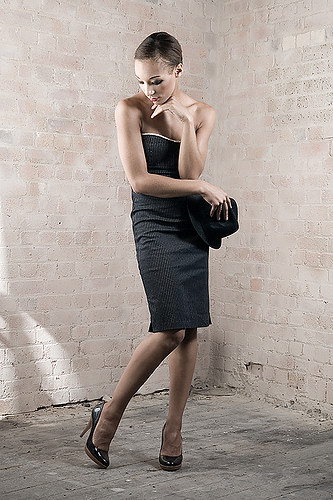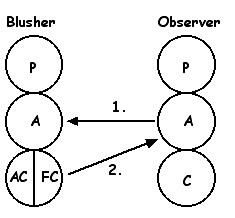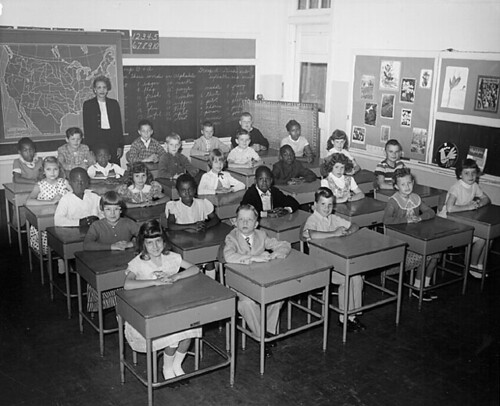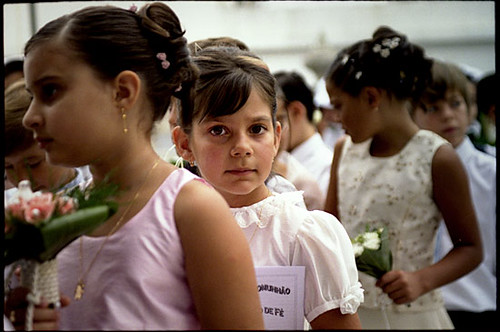I am referring to here and now shame rather than neurotic shame at this juncture. We all go through life and sooner or later circumstances arise where we will feel shame which is appropriate to the events. For most this is probably not a common occurrence and as I mentioned before the experience of embarrassment is probably much more common for most. People who were shamed as children will feel shame in response to a wider variety of events in adulthood because they have been ‘programmed’ to have that reaction.

What happens when a person feels shame or embarrassment?
Common body expression and attitudes when one experiences shame include a bowing of the head, an attempt to hide the face possibly with the hands, a blushing of the face and possible sweating, body bent over on itself and possibly a closing of the eyes. It is like the person is endeavouring to make self as small and as invisible as possible and as a result there will be a strong drive to remove self from any company and seek to isolate self for a while.
The other interesting feature of shame and embarrassment is blushing. In this instance there is a reddening of the face, neck and possibly the upper chest. This is seen to be a reaction of the sympathetic nervous system that causes the blood vessels in the face to dilate. The cheeks tend to have more capillaries and blood vessels than other parts of the body and the vessels also tend to be wider in diameter and closer to the surface. The increased blood flow results in a colour change in that area from light pink to dark red. As it is involuntary it is something that cannot be controlled which may cause even further disquiet.
It is believed that everyone has the physical capacity to blush. The whiter the skin the more observable it is. In dark skinned people it is almost impossible to notice but they do blush the same as lighter skinned people. Women tend to blush more than men. It is reported to occur in kindergarten aged child but some report that a child as young as two years old can blush. Adolescence is the stage at which it is most prevalent due to it being a period of high self consciousness. As one grows older it tends to decrease as people start to become less self conscious (in normal circumstances) and the stimulation of the blood vessels decreases with age.

From a human communication point of view blushing is an interesting phenomena. Blushing is body language like any other kind of body language and people can use it to communicate. What does it communicate to the observer of the body language? Perhaps one could draw the blushing transaction as such:

Blushing transaction
1. The blusher receives some kind of information from the other person or from the environment in some way. A woman at a party has a wardrobe malfunction in front of a group of others and exposes her breast. She does not realise until someone brings it to her attention. A wife may mention to others in front of him how her husband now has to wear a ‘nappy’ since his bladder operation.
2. In response to the incoming information the person blushes with a reddening of the cheeks. This communicates back to the observer that the blusher thinks he has broken some moral boundary or sense of personal dignity as defined by the Child ego state and he is currently feeling very bad and uncomfortable about it. They will also know he is highly motivated to end the precipitating event either by withdrawal or changing the subject and so on.
This response will be a Free Child transaction if the shame or embarrassment is an appropriate reaction to the incoming information. If the shame is not an appropriate response that would be seen as an Adapted Child reaction and form the basis of neurotic shame. The two examples cited in number 1 above could be seen to be examples where it is appropriate to feel shame.

Unfortunately many teachers have learnt that shame is a good way to control children. Whilst parents may be careful not to shame a child at home it can be happening in the classroom.
A good example of the AC (neurotic) response can be found with some social phobics. A person with such a phobia can have self defeating internal talk. When in conversation they may start thinking that the observer can see they are blushing and thus how much of an idiot they look or how embarrassing they are. They may or may not be actually blushing but the person feels they are. This makes them more uncomfortable and thus the blushing increases or is felt to increase more so.
Note the lack of Parent ego state involvement in the transactions which is typical of the difference between shame and guilt. Like guilt, shame has the capacity to curb human behaviour most notably the Free Child. Whereas guilt comes from a Parent ego state introject shame is a Child ego state driven process and hence tends to be more potent and destructive. Shame feels very unpleasant to the person and thus they will be highly motivated to change their behaviour. Shame is experienced as being more in the core of the person as compared to guilt.
Do people blush alone, is an interesting question. People certainly can feel shame whilst being alone. The woman cited above who had the wardrobe malfunction can recall that event the next day whilst alone in her home and feel shame about it. However would her feelings of shame result in blushing? She is aware she is not being observed by anyone in that instance. I am unsure of the answer to this question. I would tend to think that she would not blush or certainly any blushing that did occur would be less intense. However I have no data on which to base this conclusion.

Making children perform on stage can easily produce a shame reaction. Parents need to take care when the child is required to make some kind of public performance.
Does anyone out there have personal experience with being alone and blushing or not blushing?
Whilst my parents were by no means perfect they never did shame me as a child. Thus I have few incidents where I can recall when I felt shame as a child or an adult. There are a couple and if I recall them I do not think that I demonstrate any blushing.
This leads us to the next stage in the process of our discovery of the various components of shame. Many a client will recount incidents where they felt shame in the past. If a client experiences shame in front of the therapist what does the therapist do? Watch this space.
Graffiti
While I was reading this post... i was recalling something I did this week just passed. I am still feeling the sting of the blush in my face. I am alone.
ReplyDelete